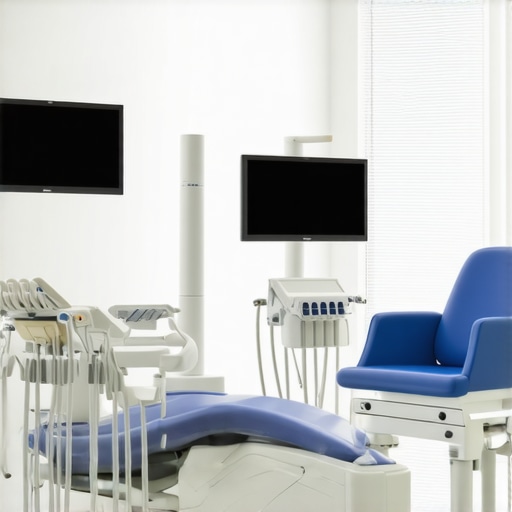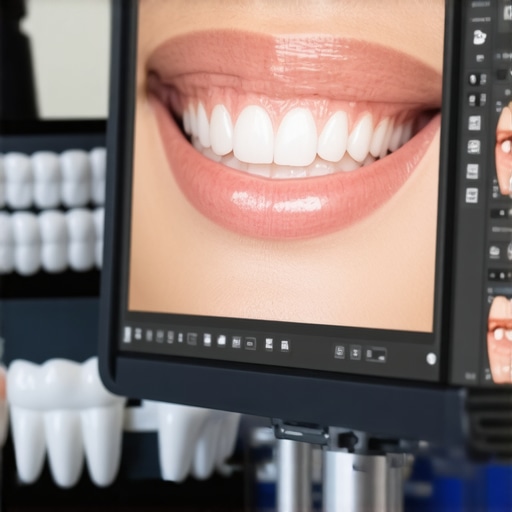Revolutionizing Family Dentistry: The Integration of Cosmetic Innovations in 2024
In the evolving landscape of dental care, 2024 marks a pivotal year where aesthetic and functional dentistry converge to redefine patient expectations. As an expert in the field, I recognize that modern family dentistry extends beyond routine check-ups, embracing sophisticated cosmetic procedures like veneers, whitening, and Invisalign to address both health and beauty. These advancements are not merely superficial; they are rooted in complex biomaterials, digital diagnostics, and minimally invasive techniques that improve patient outcomes and satisfaction.
Unveiling the Complexity of Veneers: Beyond Aesthetic Enhancement
Porcelain veneers exemplify a significant leap in cosmetic dentistry, offering durable, natural-looking solutions for various dental imperfections. Their success hinges on precise shade matching, tissue compatibility, and the ability to conserve tooth structure—an intricate balance achieved through digital smile design and CAD/CAM technology. The expertise involved ensures that veneers not only improve aesthetics but also preserve the long-term health of the dentition, making them a cornerstone of family cosmetic care in 2024.
Whitening Technologies: Scientific Precision Meets Artistry
The latest whitening protocols harness advanced bleaching agents and LED activation systems, delivering safer, more effective results. Expert practitioners understand the biochemical interactions at play, customizing treatments to minimize sensitivity while maximizing brightness. As documented by the American Academy of Cosmetic Dentistry, tailored whitening strategies are essential for achieving consistent, predictable outcomes that meet individual patient expectations (American Academy of Cosmetic Dentistry).
Invisalign and Digital Orthodontics: Redefining Alignment Strategies
Invisalign’s innovation in clear aligners involves sophisticated 3D imaging, predictive modeling, and material science to produce discreet and efficient tooth movement. This approach exemplifies how digital workflows enhance precision, reduce chair time, and improve patient compliance—especially vital in family settings where multiple generations benefit from tailored orthodontic solutions. The integration of Invisalign with other cosmetic procedures facilitates comprehensive smile makeovers, emphasizing the importance of interdisciplinary planning.
What are the current challenges and future trends in integrating cosmetic and functional dentistry for families?
This question reflects ongoing professional debates about balancing aesthetics with occlusal health, managing patient expectations, and incorporating emerging technologies such as AI-driven diagnostics and biomimetic materials. As the field advances, continuous research and practitioner expertise will be vital in navigating these complex issues.
For those seeking to elevate their practice or understand the latest in family cosmetic care, exploring detailed guides on veneers and Invisalign in 2024 can provide valuable insights. Additionally, engaging with professional forums or contributing your expertise will help shape the future standards of comprehensive dental care.
Integrating Aesthetic and Functional Excellence: The Next Frontier in Family Dentistry
As we delve deeper into 2024, the conversation shifts toward a holistic approach that marries beauty with function, emphasizing the importance of personalized, minimally invasive treatments. Modern families seek not only stunning smiles but also durable, health-promoting solutions that enhance overall oral health. This paradigm demands a nuanced understanding of material science, digital diagnostics, and interdisciplinary collaboration, shaping the future landscape of family dental care.
How Can Digital Smile Design and Biomimetic Materials Revolutionize Family Dental Treatments?
Digital smile design (DSD) has transformed how clinicians visualize and plan aesthetic outcomes, allowing for precise customization that aligns with each patient’s unique facial features and personality. When paired with cutting-edge biomimetic materials—designed to emulate natural tooth tissue—the potential for long-lasting, harmonious restorations increases significantly. These innovations reduce the need for aggressive tooth preparation, preserving natural structure and promoting healthier outcomes over generations.
Embracing these technologies not only elevates aesthetic results but also streamlines treatment workflows, ensuring efficient, predictable results. For families, this means less chair time, fewer visits, and more confidence in the longevity of their smile enhancements. For more insights on incorporating digital tools into your practice, explore veneers and cosmetic enhancements in 2024.

Could AI and Predictive Analytics Shape the Future of Family Dental Care?
Artificial Intelligence (AI) and predictive analytics are emerging as game-changers in dentistry, enabling practitioners to anticipate disease progression, personalize preventive strategies, and optimize treatment plans. These tools harness vast datasets to identify subtle patterns, offering a proactive approach rather than reactive care. For families, this translates into early detection of issues such as malocclusion or caries, tailored to their specific genetic and behavioral profiles.
However, integrating AI into family dentistry also presents challenges, including data privacy, ethical considerations, and the need for continuous professional training. As highlighted by a recent comprehensive review in the Journal of Dental Technology, successful adoption hinges on meticulous validation and adherence to ethical standards (Journal of Dental Technology).
To stay ahead of these trends, consider engaging with professional communities or visiting our contact page for personalized consultations or to share your insights.
Harnessing Digital Smile Design and Biomimetic Materials for Long-Term Dental Harmony
As the field of family cosmetic dentistry continues to evolve rapidly in 2024, the integration of digital smile design (DSD) and biomimetic materials stands out as a transformative approach. These innovations do not merely enhance aesthetic outcomes; they fundamentally reshape treatment philosophies by prioritizing natural tissue preservation, functional harmony, and patient-specific customization.
What makes Digital Smile Design a game-changer in family dentistry?
Digital Smile Design utilizes advanced 3D imaging, facial analysis, and virtual mock-ups to facilitate a comprehensive understanding of the patient’s facial aesthetics and functional dynamics. This technology empowers clinicians to craft highly personalized treatment plans that anticipate aesthetic results and occlusal stability with remarkable precision. Moreover, DSD fosters transparent patient communication, enhancing satisfaction and informed consent—crucial factors in family practices where diverse expectations coexist.
Research by the American Academy of Cosmetic Dentistry underscores that integrating digital workflows reduces chair time and minimizes errors, leading to predictable, long-lasting restorations (AACD).
How do biomimetic materials redefine the scope of minimally invasive restorations?
Biomimetic materials are engineered to emulate the physical, optical, and biological properties of natural tooth tissue. Their use in restorations, such as composite resins and ceramics, allows for conservative preparation techniques that preserve healthy enamel and dentin. This approach aligns with the principles of minimally invasive dentistry, especially vital in family settings where preserving natural tissue benefits multiple generations.
For instance, biomimetic composites enable stress distribution similar to natural dentin, reducing the risk of cracks or fractures over time. When combined with digital planning, clinicians can achieve seamless, durable restorations that integrate flawlessly with the existing dentition, enhancing both function and aesthetics.
< >
>
Embracing these advanced materials also facilitates quicker chairside procedures, reducing patient discomfort and optimizing practice efficiency. As a result, families receive durable, harmonious restorations that support long-term oral health and confidence.
Why is interdisciplinary collaboration essential in implementing these innovations effectively?
The complexity of integrating DSD and biomimetic materials requires a multidisciplinary approach, involving prosthodontists, orthodontists, and digital specialists. This collaboration ensures comprehensive planning, addressing occlusal dynamics, esthetic harmony, and functional stability simultaneously. For example, combining digital orthodontics with restorative planning can optimize the alignment and occlusion before final restorations, preventing future complications.
Furthermore, ongoing professional education and adaptation to emerging technologies are critical. As highlighted by the Journal of Esthetic and Restorative Dentistry, successful implementation hinges on continuous learning and a commitment to evidence-based practice (JERD).
To delve deeper into how digital and biomimetic innovations can elevate your practice, explore our comprehensive guides or contact our expert team for tailored advice. Embrace these cutting-edge solutions to redefine family dental care in 2024 and beyond.
Harnessing the Power of 3D Printing for Customized Dental Solutions in Family Practices
As the frontier of dental innovation expands in 2024, 3D printing emerges as a transformative tool, enabling clinicians to produce highly personalized restorations, surgical guides, and orthodontic appliances with unprecedented precision. Leveraging biocompatible resins and advanced additive manufacturing techniques, family practices can now deliver faster, more accurate, and cost-effective solutions tailored to each patient’s unique anatomy.
Integrating 3D printing into routine workflows not only streamlines treatment timelines but also enhances patient engagement by visualizing outcomes through virtual prototypes. According to a comprehensive review in the Journal of Dental Technology, this technology significantly reduces laboratory dependency and facilitates in-office fabrication, empowering families to receive comprehensive care in fewer visits.
What are the implications of AI-driven diagnostics for early detection in pediatric and adult patients?
Artificial Intelligence (AI) is revolutionizing diagnostic accuracy by analyzing vast datasets to identify early signs of dental pathologies such as caries, periodontal disease, and malocclusion. AI-powered imaging tools can detect subtle changes often missed by the human eye, enabling proactive intervention and personalized treatment planning. This is particularly impactful in pediatric dentistry, where early detection can prevent complex future issues.
For a detailed exploration, see the recent findings published by the American Dental Association, emphasizing the ethical considerations and validation protocols necessary for clinical AI adoption.
How can interdisciplinary collaboration elevate the integration of digital and biomimetic materials?
The confluence of prosthodontics, orthodontics, materials science, and digital technology creates a fertile ground for innovative treatment paradigms. Collaborative planning allows for comprehensive assessments—addressing occlusion, aesthetics, and tissue preservation—thus optimizing long-term outcomes. For instance, combining digital orthodontic planning with biomimetic restorative techniques ensures harmonious, minimally invasive, and durable results across multiple disciplines.
Ongoing education and cross-disciplinary communication are vital. Initiatives like the European Digital Education Alliance underscore the importance of continuous learning in mastering these complex integrations.
What are the ethical and practical considerations of data security in AI and digital dentistry?
As digital tools and AI systems become integral to family dental practices, safeguarding patient data assumes paramount importance. Ensuring compliance with regulations such as GDPR and HIPAA requires robust cybersecurity measures, consent protocols, and transparent data management policies. Ethical practice mandates that clinicians remain vigilant against potential breaches and misuse of sensitive health information, maintaining trust and integrity in the evolving digital landscape.
For practitioners seeking guidance, the International Association of Privacy Professionals offers comprehensive resources on data security best practices tailored for healthcare providers.
Embracing the Next Generation of Family Dental Care: Your Strategic Edge
To stay at the forefront of these technological advancements, dental professionals must commit to continuous education, invest in cutting-edge equipment, and foster collaborative networks. The convergence of digital workflows, biomimetic materials, and AI-driven diagnostics promises not only enhanced patient satisfaction but also a sustainable, forward-looking practice model. Engage actively with professional communities, participate in conferences, and explore partnerships that facilitate knowledge exchange and innovation adoption.
Discover how these pioneering solutions can redefine your practice’s future—start by visiting our expert insights portal or scheduling a consultation today to unlock the full potential of 2024’s advanced family dentistry innovations.
Expert Insights & Advanced Considerations
Innovative Material Integration
Integrating biomimetic materials with digital smile design significantly enhances restoration longevity, preserves natural tissue, and promotes functional harmony in family dentistry. This approach requires a deep understanding of material science and digital planning to optimize outcomes.
Artificial Intelligence in Diagnostics
AI-driven diagnostic tools enable early detection of subtle pathologies, facilitating proactive treatment strategies. Mastery of AI integration and data management is essential for future-ready family practices aiming for precision and efficiency.
Interdisciplinary Collaboration
Coordinating prosthodontics, orthodontics, and digital technology ensures comprehensive care, reducing future complications and enhancing aesthetic results. Continuous professional development in cross-disciplinary techniques is vital for maintaining a competitive edge.
Minimally Invasive Techniques
Adopting minimally invasive procedures with advanced biomaterials conserves natural tissue, accelerates healing, and improves patient satisfaction. Staying current with innovative protocols enhances long-term oral health in multi-generational family care.
Curated Expert Resources
- American Academy of Cosmetic Dentistry (AACD): Offers cutting-edge research, guidelines, and continuing education resources specific to aesthetic dentistry advancements.
- Journal of Dental Technology: Provides peer-reviewed articles on AI, biomaterials, and digital workflows shaping modern family dentistry.
- European Digital Education Alliance: A platform for ongoing education on digital integration and interdisciplinary collaboration in dental practice.
- International Association of Privacy Professionals (IAPP): Essential for understanding data security and ethical considerations in digital dentistry.
Final Expert Perspective
In 2024, mastering the integration of advanced materials, AI diagnostics, and interdisciplinary collaboration will define the future of family cosmetic dentistry. These innovations not only elevate aesthetic outcomes but also ensure long-term functional health, making them indispensable for modern practitioners. To deepen your expertise or share insights, consider reaching out via our contact page. Embrace these advancements to lead the next generation of comprehensive family dental care, ensuring durable, beautiful smiles for generations to come.

